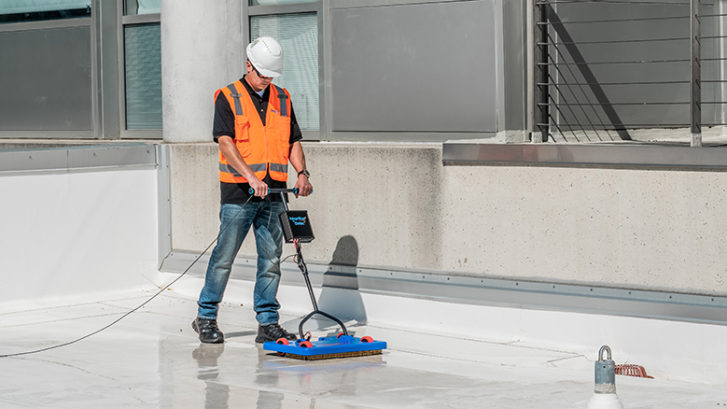Re-post from iibec.org
TITLE: Electronic Leak Detection
DESIGNATION: IIBEC-TA-018-2019 (updated 2021)
OBJECTIVE: To provide information on the methods and qualifications for electronic leak detection testing used for installed roofing and waterproofing systems.
DISCLAIMER:
This Technical Advisory is intended to serve only as a general resource and to identify potential issues for consideration by industry professionals. Each person using this Technical Advisory is solely responsible for the evaluation of the Technical Advisory in light of the unique circumstances of any particular situation, must independently determine the applicability of such information, and assumes all risks in connection with the use of such information. The materials contained in this Technical Advisory do not supersede any code, rule, regulation, or legislation and are not intended to represent the standard of care in any jurisdiction.
BACKGROUND:
With the desire to improve the service life of roofing and waterproofing systems, a need has arisen to improve both quality control (QC) and trouble-shooting techniques of these systems. The introduction of nondestructive electronic leak detection (ELD) testing has provided additional options to meet this demand. Since QC is an increasingly important aspect in today’s construction projects, ELD is becoming a commonly specified and utilized procedure to determine watertightness in roofing and waterproofing assemblies. The introduction of ELD technology occurred around 20 years ago in the North-American market and has led to increased confidence in the performance of roofing and waterproofing systems. In recent years, questions have arisen regarding differences in technology and training required to provide accurate results using ELD. This technical advisory will provide information related to ELD on the following:
- History and development of equipment currently utilized
- Current ASTM standards and how they apply
- Basic principles needed to conduct testing
- Characteristics and limitations of the different technologies
- Training and proper implementation
- Recommendations
DIFFERENT TECHNOLOGIES
The origins of ELD began with high-voltage (holiday) testing equipment. This equipment was originally designed to test corrosion-resistant coatings applied on metallic pipes and was later modified to test geomembranes, waterproofing membranes, and low-slope roofing assemblies.
Moving into the 1990s, low-voltage testing made its way slowly into the German market as a means of troubleshooting existing roofing assemblies. It quickly became evident that low-voltage equipment was also suitable for integrity testing on exposed membranes.
Low-voltage electric field vector mapping also has the ability to assist with the troubleshooting of roofing and waterproofing through different types of overburden covering the membrane, although these tests are much more difficult and challenging than testing exposed membranes and have significantly reduced reliability.
In the 1990s, low-voltage testing—electric field vector mapping—was introduced in the North American market. While ELD was first promoted as a troubleshooting tool, as it was in Europe, it quickly became apparent that many individuals in the industry were interested in using the technology as a QC tool during installation of roofing and waterproofing systems.[i] Several developments have been made in the equipment over the years to allow for QC on numerous types of roofing and waterproofing systems. Within the last ten years, conductive grids, conductive primers, and other materials have also been introduced into the market to act as alternative grounds. These are incorporated into systems to allow for testing conventional insulated roofing systems. ASTM D7877–14, Standard Guide for Electronic Methods for Detecting and Locating Leaks in Waterproof Membranes, specifies that the alternative ground be installed directly under the membrane when the electrical path to the conductive deck is interrupted.
While there are several forms of equipment utilized for ELD—such as high-voltage broom, scanning platforms, electric field vector mapping—the basic electrical theory of either high or low voltage is similar.
ASTM GUIDE D7877-14
ASTM D7877ii was introduced in 2014 and specifically explains the various pieces of equipment in use and the conditions required to perform a test. While this standard outlines the terminology and methodology associated with current electronic test methods and equipment variations, it does not address training and experience of the individual performing the tests.
Equipment Addressed in the Standard
ASTM D7877 outlines two methods of low-voltage ELD for horizontal surfaces, one method of low-voltage ELD for vertical surfaces, and one method of high-voltage ELD for horizontal and vertical surfaces, further described in the following.


